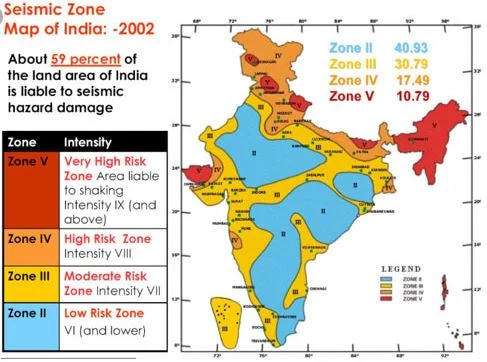Geography
Earthquakes and Delhi-NCR
- 20 Jun 2020
- 6 min read
Why in News
Recently, the Wadia Institute of Himalayan Geology (WIHG) has observed that the recent series of tremors in the National Capital Region-Delhi (Delhi-NCR) are not unusual and are indicative of strain energy build up in the region.
- WIHG is an autonomous institute of the Department of Science and Technology.
Key Points
- An earthquake cannot be predicted and the tremors cannot be described as warnings for a big event but the possibility of a stronger and life threatening earthquake cannot be ruled out.
- The vulnerability of a region can be understood from the past seismicity, calculation of strain budget, mapping of active faults etc.
- Sometimes, a vulnerable zone remains quiet, experiences small magnitude earthquakes that do not indicate any bigger earthquake or receives a sudden jolt by a big earthquake without any call.
- The Delhi-NCR has been identified as the second highest seismic hazard zone (Zone IV) but the recent events in Delhi-NCR cannot be defined as the foreshocks.
- Foreshocks: All small tremors before a major earthquake in a particular region are categorized as foreshocks.
- Scientifically all these tremors in the Delhi-NCR can be demarcated as the foreshocks only after a big earthquake takes place immediately.
Reasons for Earthquakes in Delhi-NCR
- Release of Energy: Release of strain energy through the weak zones or faults which accumulates as a result of northward movement of Indian plate and its collision with the Eurasian plate.
- Movement of Plates: The Himalayan seismic belt is the region where the Indian plate collided with the Eurasian plate and under-thrusted beneath the Himalayan wedge.
- Proximity to Himalayas: Delhi-NCR is not very far from the entire north-west and north-east Himalayan belt lies in the highest seismic potential zone V and IV, where major to great earthquakes can take place.
Seismic Zones in India
- There are four seismic zones (II, III, IV, and V) in India based on scientific inputs relating to seismicity, earthquakes occurred in the past and tectonic setup of the region.
- Previously, earthquake zones were divided into five zones with respect to the severity of the earthquakes but the Bureau of Indian Standards (BIS) grouped the country into four seismic zones by unifying the first two zones.
- BIS is the official agency for publishing the seismic hazard maps and codes.
- Seismic Zone II:
- Area with minor damage earthquakes corresponding to intensities V to VI of MM scale (MM-Modified Mercalli Intensity scale).
- Seismic Zone III:
- Moderate damage corresponding to intensity VII of MM scale.
- Seismic Zone IV:
- Major damage corresponding to intensity VII and higher of MM scale.
- Seismic Zone V:
- Area determined by pro seismically of certain major fault systems and is seismically the most active region.
- Earthquake zone V is the most vulnerable to earthquakes, where historically some of the country’s most powerful shocks have occurred.
- Earthquakes with magnitudes in excess of 7.0 have occured in these areas, and have had intensities higher than IX.
Seismic Waves, Richter Scale and Mercalli scale
- Seismic waves are the vibrations from earthquakes that travel through the Earth and are recorded on instruments called seismographs.
- Seismographs record a zigzag trace that shows the varying amplitude of ground oscillations beneath the instrument.
- The earthquake events are scaled either according to the magnitude or intensity of the shock.
- The magnitude scale is known as the Richter scale. The magnitude relates to the energy released during the earthquake which is expressed in absolute numbers, 0-10.
- The intensity scale or Mercalli scale takes into account the visible damage caused by the event. The range of intensity scale is from 1-12.
Way Forward
- Earthquakes are not predictable but there lies a probability of a large to great earthquake with magnitude 6 and more in the highest seismic potential zone V and IV, which fall in the entire Himalaya and Delhi-NCR.
- The only solution to minimise the loss of lives and properties is the effective preparedness against the earthquake. Countries like Japan have proved this, where earthquakes are a common phenomenon yet the losses are negligible.
- People’s participation, cooperation and awareness are the key to success.





